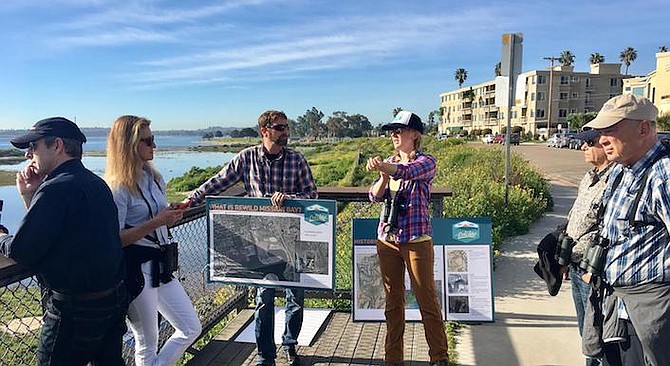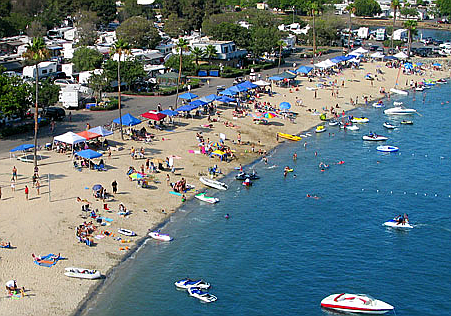 Facebook
Facebook
 X
X
 Instagram
Instagram
 TikTok
TikTok
 Youtube
Youtube

A committee formed to explore redevelopment options at De Anza Cove in the northeast corner of Mission Bay met for the sixth and final time on Thursday evening (June 29), adopting a tentative plan that seemed intended to please preservationists and RV enthusiasts, the two loudest groups involved in the debate. Both sides walked away from the meeting dissatisfied.

During the yearlong draft process, the committee fielded 162 written comments, more than 1200 additional suggestions submitted online, and received a petition from nearly 2800 supporters of Campland by the Bay, an RV park scheduled to close as part of an effort to expand natural habitat from the Kendall-Frost Marsh to Rose Creek.

Of the responses, 45 percent were related to Campland and 20 percent called for habitat restoration, making those two issues the most significant among community members contributing to the process. As numbers were announced, loud cheers erupted from competing sides of the Mission Bay Auditorium, packed with marsh supporters on the left and Campland backers on the right — some from the Campland side offered loud boos whenever conservation was mentioned.
"Just cross out whatever they have for options and write in 'we need more bay-front camping,'" an organizer for the Campland supporters instructed other members of the group, who'd gathered in the parking lot before the meeting, many wearing matching t-shirts supporting the business.
After winnowing six potential site plans down to two, the committee voted 5-1 (with one abstention) to recommend pursuit of their second alternative. This plan would give over about 40 acres of the De Anza site to Campland, which would have to relocate from a similarly-sized parcel just west of Rose Creek. A municipal golf course and other recreational facilities at the north end of the site would be preserved, while the southern tip would add about 38 acres of habitat area to the planned marsh restoration. A channel would be dredged along the southern tip of the cove, turning it into an island – the project is intended to increase water circulation at the back corner of the bay, which suffers from contamination due to poor tidal flushing.
"Right now, less than two percent of Mission Bay is preserved as natural habitat," noted Rebecca Schwartz Lesberg, the lone dissenting vote and an organizer with ReWild Mission Bay, the group developing marsh restoration plans for the area. "If we want to preserve a total of 80 acres, which is about the minimum needed to support our endangered species, we need to preserve about 200 acres today in preparation for sea level rise."
ReWild's plan called for turning over the entire peninsula to conservation use, with the only "heavy use" recreation area (including that for an RV park) being sited away from the bay where the current golf course sits.
"The plan for this area should not be a popularity contest," Schwartz Lesberg concluded, noting that the conservationists had consistently been outnumbered by RV backers throughout the process. "Our focus needs to be on the long term health of the region."
More information on the project, including the map for the preferred Alternative 2, can be found here.


A committee formed to explore redevelopment options at De Anza Cove in the northeast corner of Mission Bay met for the sixth and final time on Thursday evening (June 29), adopting a tentative plan that seemed intended to please preservationists and RV enthusiasts, the two loudest groups involved in the debate. Both sides walked away from the meeting dissatisfied.

During the yearlong draft process, the committee fielded 162 written comments, more than 1200 additional suggestions submitted online, and received a petition from nearly 2800 supporters of Campland by the Bay, an RV park scheduled to close as part of an effort to expand natural habitat from the Kendall-Frost Marsh to Rose Creek.

Of the responses, 45 percent were related to Campland and 20 percent called for habitat restoration, making those two issues the most significant among community members contributing to the process. As numbers were announced, loud cheers erupted from competing sides of the Mission Bay Auditorium, packed with marsh supporters on the left and Campland backers on the right — some from the Campland side offered loud boos whenever conservation was mentioned.
"Just cross out whatever they have for options and write in 'we need more bay-front camping,'" an organizer for the Campland supporters instructed other members of the group, who'd gathered in the parking lot before the meeting, many wearing matching t-shirts supporting the business.
After winnowing six potential site plans down to two, the committee voted 5-1 (with one abstention) to recommend pursuit of their second alternative. This plan would give over about 40 acres of the De Anza site to Campland, which would have to relocate from a similarly-sized parcel just west of Rose Creek. A municipal golf course and other recreational facilities at the north end of the site would be preserved, while the southern tip would add about 38 acres of habitat area to the planned marsh restoration. A channel would be dredged along the southern tip of the cove, turning it into an island – the project is intended to increase water circulation at the back corner of the bay, which suffers from contamination due to poor tidal flushing.
"Right now, less than two percent of Mission Bay is preserved as natural habitat," noted Rebecca Schwartz Lesberg, the lone dissenting vote and an organizer with ReWild Mission Bay, the group developing marsh restoration plans for the area. "If we want to preserve a total of 80 acres, which is about the minimum needed to support our endangered species, we need to preserve about 200 acres today in preparation for sea level rise."
ReWild's plan called for turning over the entire peninsula to conservation use, with the only "heavy use" recreation area (including that for an RV park) being sited away from the bay where the current golf course sits.
"The plan for this area should not be a popularity contest," Schwartz Lesberg concluded, noting that the conservationists had consistently been outnumbered by RV backers throughout the process. "Our focus needs to be on the long term health of the region."
More information on the project, including the map for the preferred Alternative 2, can be found here.
Comments